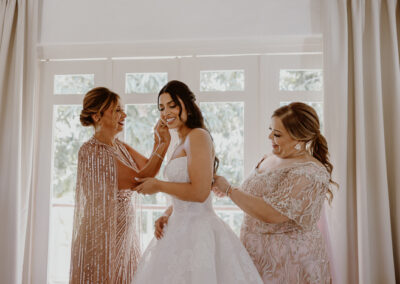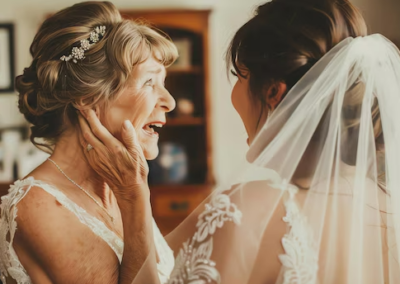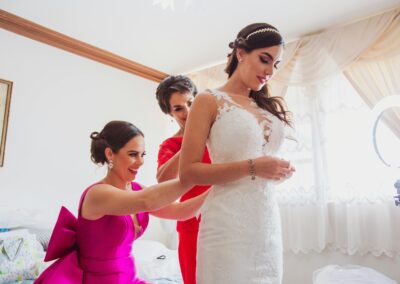What Wedding Dress Designers Are Affordable?
When you’re planning a wedding, deciding how much to spend on a dress can be a challenging task. You might wonder if you should stick to the typical 10% of the total budget or let your heart lead you to a pricier gown. It’s essential to balance dreams with practicality, reflecting on the variety of options from budget-friendly to high-end. But what about those hidden costs, like alterations or accessories, that can quickly add up? There’s more to reflect on than just the price tag and understanding these factors can guide you towards making a wise investment.

Exploring Budget-Friendly Designers
When planning a wedding, finding a beautiful gown that fits within a budget is often a top priority for many brides. Budget-friendly designers like Kennedy Blue and Kiyonna offer diverse collections, including maternity wedding dresses and eco-friendly options. Kennedy Blue provides affordable elegance, while Kiyonna focuses on plus-size inclusivity, ensuring every bride feels stunning on her special day. Lace & Liberty stands out with custom, made-to-order gowns at accessible prices. Brides seeking eco-friendly options might consider their sustainable materials. Rebecca Ingram by Maggie Sottero combines affordability with quality, perfect for brides wanting value-driven designs without sacrificing style. Consideration of the wedding dress budget is crucial, as it helps prioritize essential expenditures without overspending. Meanwhile, Willowby and Wtoo by Watters offer designer-quality dresses at a fraction of the cost, attracting trend-conscious brides. Nicole Miller’s commitment to high-quality, budget-friendly dresses makes her a popular choice, especially for those seeking maternity wedding dresses that don’t compromise on style or comfort.
The Range of Prices for Bridal Dresses
Although the allure of designer labels and custom-made gowns often attracts brides, understanding the range of prices for bridal dresses can guarantee a well-informed decision that aligns with both style and budget. Dress pricing strategies often hinge on several factors, including designer prestige, fabric choices, and design complexity. For instance, luxury materials like rich silks and handmade laces elevate costs substantially, contrasting with more affordable fabric options that still offer elegance. Recent data indicates that the average wedding dress cost in the U.S. ranges from $1,500 to $2,500, with some regional variations. The Knot’s 2023 survey places the average at $2,000, reflecting a steady increase from previous years. Brides may find that the average cost of a wedding dress represents about 10% of their total wedding budget. Simplified designs can serve as budget-friendly alternatives, retaining charm without the hefty price tag. Brides are encouraged to explore varying market options, balancing budget with desired features, while considering the impact of production timelines on overall cost.
Pre-Owned and Second-Hand Dress Options
Exploring pre-owned and second-hand wedding dress options not only offers significant cost savings but also aligns with the growing trend of sustainable fashion. Brides-to-be can find once-worn dresses, often saving 50-70% off retail, or sample sale gowns with discounts up to 90%. These choices are not only economical but also contribute to a more sustainable fashion industry by reducing waste and carbon footprints. The used wedding dress market has expanded considerably since 2020, offering brides more choices and better quality options than ever before. Vintage designs, available through second-hand options, present unique styling opportunities that are both timeless and eco-friendly. Online marketplaces like Stillwhite, Borrowing Magnolia, and Poshmark provide extensive selections, while platforms like Pre-Loved by KAREN WILLIS HOLMES emphasize full-circle sustainability. Whether opting for consignment shops or dress rental services, brides can enjoy designer gowns at a fraction of the cost, with savings on high-end brands like Vera Wang reaching up to 80%. This approach to wedding attire supports both financial prudence and environmental responsibility.
Affordable Brands Offering Wedding Dresses
In the domain of wedding attire, affordability and style are not mutually exclusive, thanks to a plethora of brands dedicated to offering brides elegant designs without the exorbitant price tags. Maggie Sottero and Rebecca Ingram are notable for their luxury-inspired collections crafted from trendy fabrics, yet they manage to maintain accessible pricing. Brands like Nicole Miller and Allure Bridals seamlessly blend sophistication with affordability, ensuring brides can walk the aisle in style.
For those seeking sustainable options, Essense of Australia and Lace & Liberty offer eco-friendly designs without compromising on elegance. Willowby by Watters and Wtoo by Watters present luxurious materials at modest prices, appealing to fashion-forward brides. Online retailers like Lulus and BHLDN provide a chic selection of budget-friendly dresses, catering to both bohemian and classic tastes. Meanwhile, Anthropologie and Meshki showcase versatile designs, ensuring brides can find their dream dress without breaking the bank. Local bridal boutiques often have brand-new gowns available at affordable prices, offering brides the chance to find stylish yet budget-conscious options.
Tips for Saving Money on Wedding Dresses
When traversing the world of wedding dress shopping, strategic approaches can greatly reduce costs without sacrificing style. First, consider pre-owned dresses from sites like PreOwnedWeddingDresses.com or sample sales from local bridal stores; these options offer designer gowns at a fraction of the cost. Sample sales and floor samples provide quality dresses with minimal wear, perfect for budget-savvy brides. Bridal sample sales can lead to discounts of up to 50% or more, making them an attractive option for finding affordable high-quality dresses.
Timing is essential—buying during off-season or holiday sales and signing up for newsletters can reveal significant discounts. Attending trunk shows also allows brides to explore full collections and save on designer pieces.
Alteration tips are important: opt for dresses with adjustable features like lace-ups or corsets to minimize alteration expenses. While professional tailoring is recommended for a perfect fit, those with sewing expertise might consider DIY alterations. Finally, choosing dresses with flexible sizing and larger seam allowances can further ease alteration costs.
Understanding the Average Wedding Dress Cost
While smart shopping strategies can help brides save on wedding dresses, understanding the average cost is key to setting realistic expectations and budgets. In 2025, the average bridal gown costs between $1,500 and $2,500, though options exist at every price point. An essential factor affecting price is the wedding dress materials chosen. Luxury fabrics like silk and handmade lace elevate costs due to their quality and craftsmanship. However, affordable options can be found at retailers like David’s Bridal and Azazie, along with big-box stores like ASOS and Lulus. Customizations impact the budget considerably, as personalized touches and intricate designs often incur additional fees. Alterations, for instance, typically range from $300 to $800. Opting for designer labels, such as Oscar de la Renta, can further increase expenses, while lesser-known brands might offer affordable yet exquisite alternatives. Market trends reveal a growing selection of budget-friendly gowns, starting as low as $100, particularly from big-box retailers. Brides seeking couture styles should expect prices beginning at $2,000, reflecting the exclusivity and detail involved.



